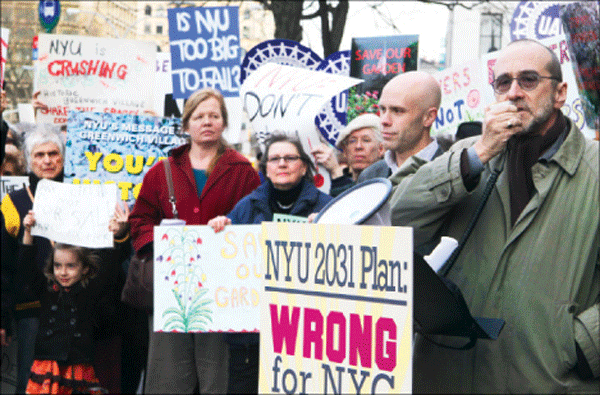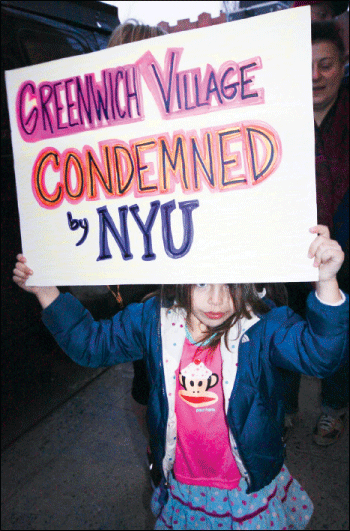 [/media-credit]
[/media-credit] [/media-credit]
[/media-credit]
The people crowding into the meeting in the Church of St. Anthony of Padua’s basement hall were many seniors, a few young children, gardeners, dog walkers, New York University faculty, superblocks residents and Downtowners who live near the superblocks or farther away — all united against a plan they feel would destroy the Village’s very character.
At the meeting’s start, Brad Hoylman, C.B. 2 chairperson, announced that the board had passed a resolution “that firmly rejects the N.Y.U. plan.”
His words were greeted with a thunderous, standing ovation.
The board held a dozen meetings over two months to consider various aspects of the plan as part of its review of N.Y.U.’s application to the city for approval under ULURP — the uniform land use review procedure, a process that can take around seven months in total.
Of those meetings, Hoylman said, “I’ve got to be honest — we haven’t heard from one member of the community who isn’t employed by N.Y.U. who supports the plan.”
In a lengthy and detailed, 20-page resolution, the board raised concerns with every aspect of the plan — from long shadows that would be cast by proposed large buildings, to noise from 20 years of construction to the loss of open public space.
The public “Philosophy Garden” that N.Y.U. proposes for the middle of Washington Square Village would, in fact, feel like a hemmed-in, private campus space, according to C.B. 2.
N.Y.U. should not be allowed to acquire any of the open-space strips along Mercer St. and LaGuardia Place, C.B. 2 further said, citing the vibrant community uses currently on these parcels, as well as N.Y.U.’s failure to adequately maintain significant portions of them over the years.
The university also should make a “transparent commitment to [creating] a public school,” the board said.
In addition, the commercial zoning that N.Y.U. is seeking for the blocks east of Washington Square Park should be denied, the community board stated. Among other concerns, if approved, this change could lead to retail stores bordering the park’s eastern side, the board noted.
C.B. 2’s resolution concluded: “Shifting the university center south and establishing a more intense campus environment on the superblocks would forever destroy a thriving residential community and transform it into a private N.Y.U. campus, changing the character of the area forever. It would also have significant impacts on surrounding neighborhoods to the east, south and west, such as Noho, Soho and the West Village — areas where students are not a dominant presence.”
Under its plan, N.Y.U. would add 2.5 million square feet of space to the superblocks, with more than 1 million square feet of that belowground. There would be four new buildings, including an N.Y.U. hotel, a large freshman dormitory, a new gym and classroom and office space. The university has also committed to giving the city’s School Construction Authority land — but not cash — to build a new public school on the current Morton Williams supermarket site at the southern superblock’s northwestern corner. A temporary gym would also be built in the middle of Washington Square Village on the northern superblock for exclusive use by N.Y.U.’s men’s and women’s varsity basketball and volleyball teams. C.B. 2, in its resolution, said the temporary gym should be built elsewhere.
In a statement after the meeting, Hoylman said, “I am extremely pleased that C.B. 2 is now on record strongly opposing N.Y.U.’s plan, which threatens to destroy the neighborhood character of the Village. But there is a lot more work to be done. I hope the detailed resolution from the community board will provide a road map for our elected officials as we continue discussions with the city and N.Y.U. and helps send this plan back to the drawing board.”
Members of the public testified before the board’s vote, though not in the same numbers as at the board’s January meeting when 87 people testified. This time, less than half that number testified. After all, the board’s resolution had already been drafted prior to last Thursday evening’s meeting.
Beth Gottlieb, president of the Mercer-Houston Dog Run Association, warned local elected officials they better listen to the community and C.B. 2 or they will feel payback come Election Day.
Referring to the two so-called “Boomerang Buildings” that N.Y.U. hopes to add within Washington Square Village, she said, “Elected officials, take heed. If you ignore your community, that boomerang is coming back at you!”
The dog run is on an open-space strip that the university wants to acquire to build its new “Zipper Building.”
Another resident who lives south of the superblocks vowed to chain himself to one of the cherry trees outside Coles gym if N.Y.U. tries to demolish the gym and develop on the Mercer open-space strip where a grove of the trees flourishes to his great joy.
Artist and gardener Rhoma Mostel, niece of Zero Mostel of “Fiddler” fame, blasted the interim gym idea.
“It’s wasteful and ecologically insane to build a temporary gym on Sasaki Garden,” she said.
Jeanne Wilcke, president of Downtown Independent Democrats, called out local politicians who have refused to fight the plan so far — or even to take a clear, forceful public position on it.
“We elect our officials to lead the charge, not look at the plans and say, ‘We’ll decide later,’ ” she said angrily. “This plan should have been stopped dead in its tracks years ago.”
Again, Wilcke indicated there will be repercussions for failing to support the community in its fight against the university’s development.
“If our public officials do not stand with us now,” she said, “we have no reason to stand with them later.”
As part of ULURP, the N.Y.U. 2031 Plan next goes to Borough President Scott Stringer for review, then to City Planning, then to the full City Council for a final vote. To date, Councilmember Margaret Chin has not stated her position on the plan, other than to join fellow local elected officials at a rally in December 2010 calling for the open-space strips to remain public.
Before the meeting, Andrew Berman, director of the Greenwich Village Society for Preservation, led a large rally outside St. Anthony’s Church.
“This plan is opposed by N.Y.U.’s neighbors, its faculty, its students and many of its own alumni,” Berman said. “The university is seeking to cram a massive amount of space which they can’t even afford to build into a neighborhood that can’t sustain and doesn’t want it.”
Mark Crispin Miller, a media studies professor at N.Y.U. and a leader of the faculty opposition to the plan, said their “math people” figured out its cost: $6 billion. This was a simple calculation of $1,000 of construction cost per square foot, he said. Only 2.5 million of the 6 million square feet N.Y.U. says it needs to develop by 2031 would be located on the superblocks, however, if the plan is approved. N.Y.U.’s endowment is currently only $2.8 billion.
In a statement, Alicia Hurley, N.Y.U. vice president for government affairs and community engagement, said, “N.Y.U. appreciates the community’s feedback to date and believes that our five-year dialogue with our neighbors has already yielded tremendous results. Thus far, in response to the community’s requests, we’ve produced a strategic plan that helps our neighbors better understand our space needs; allows us to grow on our own footprint; with a full half of our projected growth on space outside the Village; and provides parkland and open space and the donation of a $23 million location for a new public school.” (N.Y.U. purchased the Morton Williams parcel for that sum about 10 years ago.)
One group that came out enthusiastically for the N.Y.U. plan was the Greenwich Village-Chelsea Chamber of Commerce.
“From the Chamber’s point of view, the thousands of students and faculty at N.Y.U. are great generators of commerce and trade for local businesses in Greenwich Village,” said Tony Juliano, the Chamber’s president. “During spring commencement, some 30,000 people spend time in the Village and another 15,000 visit during fall semester back-to-school days. The university also hosts more than 50,000 prospective students and families every year for information sessions and tours. All these visitors utilize our hotels, restaurants and shops, supporting local merchants, strengthening our neighborhood’s economy and ensuring our neighborhood is a place where small businesses can thrive.”

















